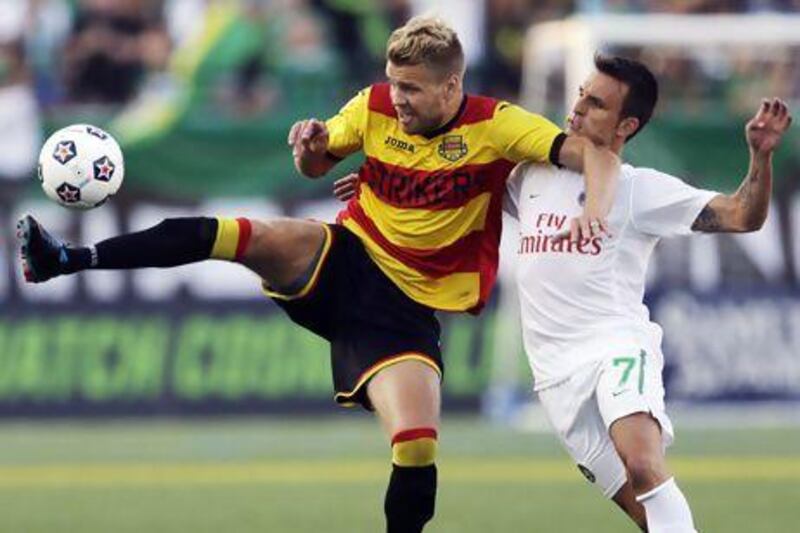On August 14, 1977, New York Cosmos played Fort Lauderdale Strikers at Giants Stadium in a play-off match. In front of 77,691 fans – still a record attendance figure for a North American club football match – Pele, Franz Beckenbauer and Giorgio Chinaglia inspired the home team to a lopsided 8-3 win over the stunned visitors from Florida, who had England World Cup-winning goalkeeper Gordon Banks in goal.
After the match, the players would have continued the celebration at Studio 54 alongside New York's "in" crowd, which often included the likes of Mick Jagger, Andy Warhol and Michael Jackson.
Such was the glamour of the North American Soccer League (NASL) in those days. The party didn't last, of course; the Cosmos, like the league, went out of business in 1984.
Twenty-eight years of false starts and a stratospheric US$100 million (Dh367m) later, the owner Seamus O'Brien and his Saudi partner Mohiedin Kamel have resurrected the Cosmos.
On Saturday, just under 12,000 fans turned up to Hofstra University's modest Shuart Stadium for a somewhat more low-key clash with the new Fort Lauderdale Strikers.
Pele was there, as honorary president of the club. But little else was the same. With the exception of the former Spain international Marcos Senna, the names were unrecognisable to most football fans.
A mixture of old and young saw a 2-1 Cosmos victory, thanks to goals by Peri Marosevic and an injury-time winner from Alessandro Noselli. The New Yorkers had taken the first, small step toward a return to former glories.
Whether giant leaps will be taken anytime soon, however, is by no means certain.
Today's NASL, launched in 2006, is essentially American soccer's minor league. The Cosmos may have their legendary name to sustain them, but the same cannot be said for the other seven teams, none of which enjoy the traditional fan base or pop-culture-curiosity value that the New York team has.
The old Cosmos basked in the spotlight of the original NASL; the modern reincarnation faces the altogether more daunting task of breaking out of a competition that exists firmly in the shadow of Major League Soccer (MLS).
Like the old version of the NASL, the MLS may still attract some star names nearing the end of their careers, but that is where the similarities end. Where the former was, in hindsight, nothing more than a house of cards, the latter is a sustainable project. Football in the US has long ceased to be a fad.
Today, the US national team is ranked 22nd in the world, and last week won the Concacaf Gold Cup with a core of home-grown players. In 1980, at the height of the NASL, the US national team was a nonentity, 30 years on from their previous World Cup appearance, 10 away from their next. The coming season will be the MLS's 18th, and average attendances last term hovered just above 18,000. It is a different kind of party to the one Pele, Eusebio and Johan Cruyff enjoyed in semi-retirement. And it is more exclusive.
The MLS, like all sports leagues in North America, remains a closed shop, and there is no system of promotion and relegation. Unlike football leagues around the world, the MLS is not a collection of independently owned clubs; it is a single entity, where each team is owned and controlled by the league's investors.
Last season, Montreal Impact became the league's 19th team, and the Manchester City-affiliated New York City FC will join in 2015. Further expansion cannot be ruled out, so O'Brien and Kamel can still dream big. But it could be a long wait.
The Cosmos will soon also face the added handicap of being the smallest, if certainly not the least-known, of three New York clubs - behind New York City FC and the established New York Red Bulls.
It is not unheard of for a big city to sustain three, or more, major teams. Istanbul is home to Galatasaray, Fenerbahce and Besiktas. In Brazil, Sao Paulo has Palmeiras, Santos, Sao Paulo, and Corinthians. London will next season boast six Premier League clubs; three finished the last campaign in the top five.
These are, however, established clubs in cities consumed by football passion. New York is not quite there, and the Cosmos would be up against their two soccer rivals, as well as baseball, basketball, American football and hockey franchises.
O'Brien and Kamel have no choice but to do it the hard way. New York Cosmos may be back, but it could be a while before they are back in the big time. Do not expect to see Senna schmoozing with Robert de Niro at Nobu anytime soon.
Follow us
[ @SprtNationalUAE ]





